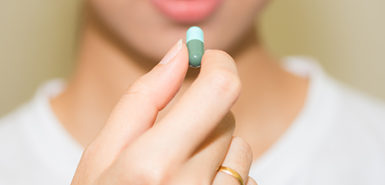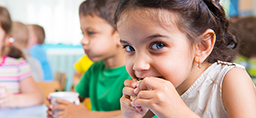
The human body is teeming with bacteria—some good, some bad.
It’s a delicate balance in there. And it can change at a moment’s notice, depending on any number of factors that shape the invisible ecosystem inside and outside our bodies.
One species of fungus that naturally grows in and on humans is candida. It’s a normal flora in the human mouth, gastrointestinal and genitourinary tracts, said Miranda Hillard, MD, pediatrician at Spectrum Health Helen DeVos Children’s Hospital.
But what happens if the balance shifts? And how might it shift?
Illnesses, environmental changes, dietary changes, antibiotic usage and various other conditions can give rise to a candida overgrowth.
“When we use antibiotics, we kill good bacteria along with the bad bacteria,” Dr. Hillard said. “This imbalance can make it easier for undesirable species to overgrow.”
Infants and toddlers are particularly prone to a condition known as thrush, which is caused by an overgrowth of candida.
Thrush symptoms
“Sometimes, there are no symptoms at all,” Dr. Hillard said. “But if a caregiver notes white plaques that are ever-present on the tongue, they may want to bring baby in to be checked.”
If you see white lesions on the gumlines or on the palate, that’s concerning for candida overgrowth, she said.
Infants with thrush may eat fine, or they might refuse to eat and swallow because of pain.
Candida thrive in warm, moist areas, so it’s important to check the diaper area and skin folds for possible overgrowth of yeast, Dr. Hillard said.
The good news: Most thrush in infants is not severe.
“Most episodes of thrush are considered mild cases—those involving less than 50% of the oral mucosa and an absence of deep, erosive lesions,” the doctor said.
Severe cases, which are more extensive, can extend into the esophagus, the muscular tube that transports food from the mouth to the stomach.
The most common type of thrush is limited to the mouth—and it’s considered mild.
Therapies and treatment
Dr. Hillard always suggests treatment with topical rather than systemic antifungal therapy to start.
“Topical therapy means that we will directly put the antifungal medication on the patches of overgrowth, rather than give your infant a medication that needs to be swallowed and processed by the body to clear the infection,” she said.
This typically requires a prescription of Nystatin, an antifungal liquid suspension.
You can apply it to your baby’s mouth four times daily for one to two weeks.
“It can be squirted into the mouth directly or applied with gauze or a cotton swab,” Dr. Hillard said. “I usually tell parents to dip a cotton swab or Q-tip in the nystatin solution and ‘paint the lesions.’”
This should be done four times a day for two to three days, until you no longer see any white patches in the mouth, she said.
You can prevent reinfection by decolonizing or sterilizing all items that have been in the infant’s mouth, Dr. Hillard said. Bottle nipples and pacifiers should be boiled after each use.
“If the mother is breast-feeding, she should be treated for candida infection, too,” she said. “This can usually be done topically.”
If symptoms persist beyond two weeks, there could be issues with re-exposure from contaminated pacifiers or bottle nipples, Dr. Hillard said.
But an infection with an unusual species could also be at play. In that case, it would be wise to see your child’s pediatrician again.
Not a DIY project
Doctors don’t typically approve of DIY solutions for thrush.
“A lot of the home remedies—salt, yogurt, baking soda, apple cider vinegar—would be difficult to use in an infant, especially since you need to apply the therapy multiple times per day,” Dr. Hillard said.
Most at-home remedies center around creating an environment that’s less hospitable to fungal growth. This helps discourage the overgrowth of the candida species, Dr. Hillard said.
“When I see thrush in my clinic, I am going to treat it,” she said.
Again, nystatin is the tool of choice.
“Medicated nystatin will be more effective and is generally well-tolerated,” she said. “It’s suspended in a sweet solution, so the infants don’t mind it.”
The best at-home remedy is to simply boil objects and items the infant comes in contact with. This helps prevent re-infection.
Other remedies may be effective, but they should be approached with caution.
Gentian violet, applied to the mucosa once or twice daily, has shown some effectiveness against candida—but it carries risk.
“Gentian violet is also associated with increased risk of cancer,” Dr. Hillard said. “It can also stain the infant’s lips and clothing and it may cause irritation and ulceration.
“Given the availability of other effective agents, we generally do not recommend gentian violet.”
 /a>
/a>
 /a>
/a>
 /a>
/a>